If you’re new to the exhilarating world of skiing, you might be wondering which type of skis will be your trusty companions as you venture down the slopes. One option that often pops up in discussions among skiers is carving skis. Carving skis have gained a reputation for their ability to make those perfect, graceful turns and provide stability on the well-groomed slopes. But are they the right choice for beginners?
Yes, carving skis are excellent for beginners. They offer easier turn initiation, increased stability, and forgiveness, making the learning curve more enjoyable. However, they may have limitations on off-piste terrain and top speed.
Are they for you? Let’s find out! Let’s delve into the pros and cons of carving skis for beginners, consider the factors to keep in mind when picking your skis, and offer some tips to ensure you have an unforgettable skiing experience.
Understanding Carving Skis
Before we answer the burning question of whether carving skis are a beginner’s best friend, let’s make sure we’re on the same page about what carving skis are and how they set themselves apart from other ski types.
What Are Carving Skis?
Carving skis, sometimes lovingly called “shaped skis,” belong to the alpine ski family and are specifically designed to make those impeccable turns on groomed slopes. What sets them apart visually are their narrow waist and broad tips and tails. These skis boast a deep sidecut, meaning that the tips and tails are wider than the waist. This clever design makes it easier for you to tip them on their edges and create those smooth, arcing turns that skiing aficionados adore.
How Do Carving Skis Differ from Traditional Skis?
Now, let’s talk about the difference between carving skis and their more traditional counterparts. Traditional skis, affectionately known as “straight skis,” have a more uniform width from tip to tail, resulting in a less pronounced sidecut. These skis require a bit more effort from you to get those turns started and are a tad less forgiving, especially for beginners. Carving skis, on the other hand, are designed to be the best friends of novice skiers. They make initiating turns feel like a breeze, offer a sense of control that’s comforting, and give you a more stable skiing experience overall.
Pros of Carving Skis for Beginners
Now that we’ve got the basics down, let’s explore the advantages of choosing carving skis for your skiing journey as a beginner.
1. Easier Turn Initiation
One of the most fabulous perks of carving skis for beginners is how effortlessly they help you start your turns. That deep sidecut and those broad tips and tails make it a cinch for you to engage the edges and kickstart those turns. With carving skis by your side, you’ll find your confidence soaring, and you’ll be gliding down the slopes with style in no time.
2. Increased Stability
Carving skis are your trusty companions when it comes to stability, especially on those meticulously groomed slopes. They offer a sense of control that’s like having a sturdy pair of training wheels on your bike. No more wobbling or fearing a loss of balance – carving skis have your back. This added stability can do wonders for your confidence and your progress as a skier.
3. Forgiving Nature
Carving skis are known to be quite forgiving. They give you a broader platform to balance on, which can save the day when you make those small errors in judgment. Thanks to their forgiving nature, the learning curve won’t feel as steep or intimidating, making your ski adventure all the more enjoyable.
4. Enhanced Performance on Groomed Slopes
Groomed slopes are often the preferred playground for beginners, and that’s where carving skis truly shine. Their design is tailor-made for delivering those silky-smooth and oh-so-precise turns on these expertly maintained runs. Carving skis are the perfect companion for those looking to build their skills on groomed terrain before venturing into more challenging slopes.
5. Versatility
While carving skis excel on groomed slopes, they are also versatile enough to tackle a variety of conditions. As you gain more experience and confidence, you might want to explore different types of terrain. Carving skis can adapt to your evolving skiing style, making them a long-term investment that will accompany you on many adventures.
Cons of Carving Skis for Beginners
As with any choice, there are some downsides to consider when opting for carving skis, especially as a beginner.
1. Limited Off-Piste Performance
Carving skis are primarily designed for the beautifully groomed slopes, which means they might not be your best buddies when you venture off-piste into ungroomed terrain. If your skiing dreams include conquering more challenging and diverse ski conditions, you might find carving skis less suited for the job.
2. Reduced Speed
Carving skis tend to prioritize control and precision over top speed. While this may not be a significant concern for beginners who are still getting their sea legs, advanced skiers who live for the thrill of high-speed skiing might prefer different types of skis.
3. Missing Out on Traditional Skiing Experience
Starting with carving skis might mean you miss out on the classic experience of skiing on traditional straight skis. These traditional skis demand a bit more effort to initiate turns and offer a different sensation that some skiers genuinely appreciate. Learning to ski on traditional skis can provide you with a more well-rounded understanding of the sport.
Factors to Consider When Choosing Carving Skis for Beginners
If carving skis have won your heart and you’re ready to take the plunge as a beginner, there are several factors to keep in mind to make sure you’re making the right choice:
1. Ski Length
Finding the right length for your carving skis is like finding the perfect pair of shoes – it’s crucial for a comfortable fit. Shorter skis are generally more manageable and maneuverable for beginners, while longer skis offer greater stability, especially at higher speeds. Seek advice from an experienced salesperson or a friendly ski instructor to determine the ideal ski length for your unique needs.
2. Ski Width
While carving skis have a narrower waist compared to traditional skis, there’s still some variation in their width. A narrower waist translates to quicker and more responsive turns, while a slightly wider waist offers additional stability. Many beginners find their sweet spot with skis that have a waist width ranging from 70mm to 85mm – a perfect balance between agility and stability.
3. Flex
The “flex” of carving skis refers to how they bend under pressure. For beginners, it’s a wise choice to go for skis with a softer flex. Softer flex makes it easier for you to initiate turns and maintain control, ensuring your skiing experience is both enjoyable and less physically demanding.
4. Bindings
Don’t forget about those trusty bindings. Ensuring that the bindings on your carving skis are appropriately adjusted for your weight and skiing ability is crucial for your safety and performance on the slopes. Let a professional ski technician handle this task to guarantee everything is in tip-top shape.
5. Budget
Last but not least, consider your budget when selecting carving skis. While it’s tempting to splurge on top-of-the-line skis, there are plenty of affordable options that are perfectly suited for beginners. Be sure to account for the cost of bindings and other necessary gear when setting your budget.
Tips for a Memorable Skiing Experience with Carving Skis
If carving skis have earned a special place in your skiing heart, here are some tips to ensure your skiing journey is unforgettable and filled with those perfect turns:
1. Take Lessons
No matter which skis you choose, taking lessons from a certified ski instructor is a brilliant move, especially for beginners. Instructors are like your skiing fairy godparents, providing invaluable guidance on proper technique, safety, and how to make the most of your carving skis.
2. Practice on Groomed Slopes
For beginners, starting your skiing adventure on groomed slopes is like learning to ride a bike on a smooth, paved road. These well-maintained runs are the ideal terrain for carving skis, allowing you to build your skills and confidence step by step.
3. Focus on Technique
Carving skis are designed to make you look like a pro, but don’t forget to hone your skiing technique. Pay attention to maintaining a balanced stance, using proper edging techniques, and shifting your weight effectively to maximize the benefits of your skis.
4. Gradually Increase Difficulty
As you gain experience and your confidence grows, don’t hesitate to explore different slopes with varying levels of difficulty. It’s all part of your skiing journey and will help you progress as a skier while making the most of your carving skis.
5. Maintain Your Gear
Last but not least, show some love to your carving skis. Regularly check and maintain both the skis and bindings to ensure they’re in tip-top condition. Well-cared-for equipment is not only essential for safety but also for top-notch performance on the slopes.
Conclusion
In conclusion, carving skis, often referred to as easy carvers, are an excellent choice for beginners who are new to the slopes and learning to turn. They provide easier turn initiation, increased stability, and forgiveness, making the learning curve more enjoyable. However, it’s worth noting that they may have limitations on off-piste terrain and top speed.
Ultimately, the choice should align with your unique needs and circumstances. Take into account factors like ski length, width, flex, bindings, and budget when selecting carving skis for beginners. And always remember, regardless of your choice of skis, taking lessons and focusing on proper technique are the secret ingredients for an unforgettable and exhilarating skiing adventure.
In the end, if you decide to start your skiing journey with carving skis here is a buying guide.










